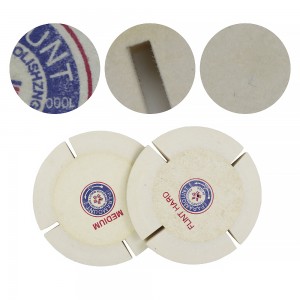The wool felt wheel market is experiencing a significant boom, driven by a confluence of factors ranging from growing industrial demand to the increasing popularity of DIY projects. This surge in interest is not only reshaping the market dynamics but also presenting new opportunities and challenges for manufacturers, suppliers, and consumers alike.
One of the primary drivers of the wool felt wheel market growth is the expanding industrial applications. In the metalworking industry, for example, the need for high – precision polishing of metals such as aluminum, brass, and copper has led to a soaring demand for wool felt wheels. These wheels are preferred for their ability to provide a smooth, scratch – free finish, which is essential for components used in aerospace, automotive, and electronics industries. As these sectors continue to grow, especially with the advancements in electric vehicle manufacturing and the miniaturization of electronics, the demand for wool felt wheels is expected to rise further.
The woodworking and furniture industries are also major contributors to the market growth. Wool felt wheels are widely used for wood finishing, helping to create a beautiful, glossy surface on furniture pieces. With the increasing consumer preference for high – quality, hand – crafted furniture, the demand for wool felt wheels for wood polishing has witnessed a steady increase. Additionally, in the restoration and refinishing of antique furniture, wool felt wheels play a crucial role in bringing back the original luster of the wood without causing any damage.
The DIY and hobbyist segment has emerged as a significant force in driving the growth of the wool felt wheel market. The rise of online tutorials and the growing popularity of home improvement projects have inspired more people to take up DIY polishing tasks. Whether it’s polishing jewelry at home, refinishing a bicycle, or restoring a vintage car, DIY enthusiasts are constantly on the lookout for reliable and effective polishing tools. Wool felt wheels, with their ease of use and versatility, have become a favorite among this group. The availability of affordable wool felt wheel sets and the convenience of online shopping have further fueled the demand from DIYers.
In addition to end – user demand, market growth is also being spurred by strategic initiatives from manufacturers. Many companies are focusing on product innovation, as mentioned earlier, to differentiate themselves in the market. By developing specialized wool felt wheels for niche applications, such as wool felt wheels for polishing musical instruments or sports equipment, manufacturers are able to tap into new customer segments. Moreover, the expansion of distribution channels, both online and offline, has made it easier for consumers to access wool felt wheels, thereby increasing market penetration.
However, the wool felt wheel market is not without its challenges. Intense competition among manufacturers has led to price wars in some segments, which may affect the profitability of smaller companies. Additionally, fluctuations in the cost of raw materials, especially wool, can impact the production costs and, consequently, the selling prices of wool felt wheels. To overcome these challenges, manufacturers are exploring alternative materials and cost – effective production methods while also focusing on building strong brand identities.
Looking ahead, the future of the wool felt wheel market appears promising. With the continuous growth of industries that rely on polishing, the increasing adoption of wool felt wheels in emerging economies, and the ongoing innovation in product design and technology, the market is expected to expand further. Manufacturers will need to stay ahead of the curve by investing in research and development, improving their supply chain management, and enhancing customer service to capitalize on the opportunities presented by this booming market.

Post time: Jun-13-2025
